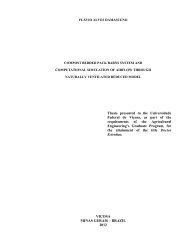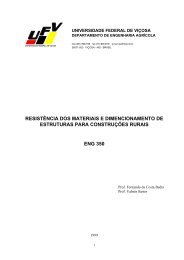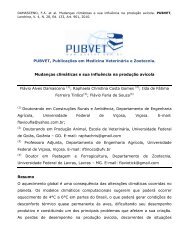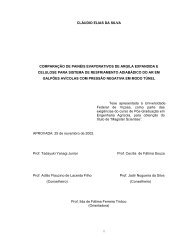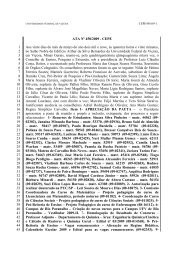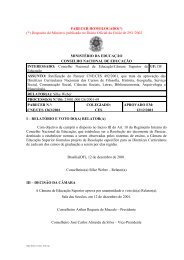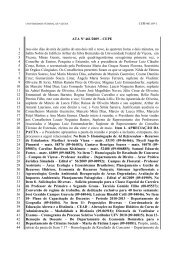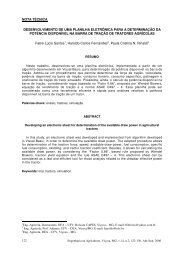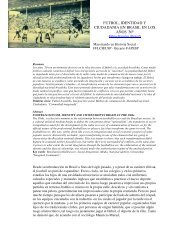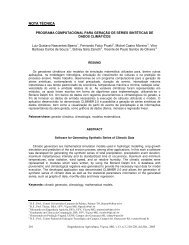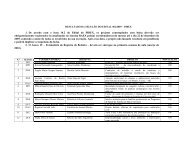ALKALOID BIOSYNTHESIS IN PLANTS: Biochemistry, Cell ... - UFV
ALKALOID BIOSYNTHESIS IN PLANTS: Biochemistry, Cell ... - UFV
ALKALOID BIOSYNTHESIS IN PLANTS: Biochemistry, Cell ... - UFV
Create successful ePaper yourself
Turn your PDF publications into a flip-book with our unique Google optimized e-Paper software.
<strong>ALKALOID</strong> <strong>BIOSYNTHESIS</strong> <strong>IN</strong> <strong>PLANTS</strong> 45<br />
vesicles, to the vacuole. BBE is likely inactivated by the acidic conditions in the<br />
vacuole, suggesting that alkaloid synthesis occurs before the enzyme crosses the<br />
tonoplast membrane. The vacuolar accumulation of sanguinarine suggests that<br />
the entire contents of the transport vesicles, including BBE and various alkaloid<br />
intermediates, might be translocated directly from the ER to the vacuole.<br />
Another example of novel subcellular compartmentation involves the biosynthesis<br />
of lysine-derived quinolizidine alkaloids, which occur in the mesophyll<br />
chloroplasts of legumes such as lupin (179). Recently, the biochemical localization<br />
of two acyltransferases that catalyze the last two acylations of (+)-pcoumaroylepilupinine<br />
and (−)-13α-tigloyloxymultifluorine showed that one enzyme<br />
occurs in the cytoplasm, whereas the other resides in the mitochondria of<br />
Lupinus albus (166). In animal cells, the acyl donor tigloyl-CoA is derived from<br />
isoleucine in the mitochondria, possibly explaining the mitochondrial localization<br />
of the terminal acyltransferase in plants. Although the quinolizidine nucleus<br />
appears to be synthesized in the chloroplast, subsequent modifications can occur<br />
only after alkaloid intermediates are transported to the cytosol and mitochondria.<br />
Ultimately, quinolizidine alkaloids are thought to accumulate in vacuoles of lupin<br />
epidermal cells, where their defensive properties are most effective (178).<br />
REGULATION OF <strong>ALKALOID</strong> BIOSYNTHETIC GENES<br />
Developmental Regulation and Tissue-Specific Localization<br />
Alkaloid biosynthetic pathways are under strict developmental regulation in plants.<br />
This fact has severely restricted the exploitation of cultured plant cells for the production<br />
of valuable metabolites. For example, C. roseus cell cultures accumulate<br />
tabersonine and catharanthine, but not vindoline or vinblastine (108). Similarly,<br />
opium poppy cell cultures can be induced to accumulate sanguinarine, but do not<br />
synthesize morphine (37). The inability of dedifferentiated cell cultures to produce<br />
vindoline or morphine suggests that the biosynthesis of many alkaloids requires<br />
the differentiation of specific cell types.<br />
The developmental regulation of TDC, STR, and four enzymes involved in<br />
vindoline biosynthesis (T16H, NMT, D4H, and DAT) has been studied in considerable<br />
detail. These enzymes are developmentally controlled in developing<br />
C. roseus seedlings, and some are further regulated by light (27, 30, 163). For<br />
example, C. roseus seedlings grown in the dark accumulate high levels of tabersonine<br />
and smaller amounts of four other vindoline pathway intermediates (8).<br />
The transfer of etiolated seedlings to light caused the turnover of tabersonine and<br />
other intermediates to vindoline, suggesting that some enzymes in the pathway are<br />
light regulated. The strict light activation of T16H in C. roseus seedlings (163)<br />
and cell cultures (151) was shown to be transcriptionally regulated. NMT activity<br />
increased ∼30% when etiolated C. roseus seedlings were exposed to light (30).<br />
D4H activity is also light induced (23), and the D4H gene has been shown to<br />
be under multilevel developmental and light-mediated regulation (175, 174). For



